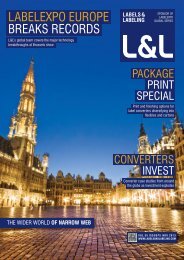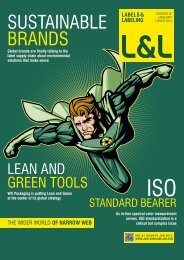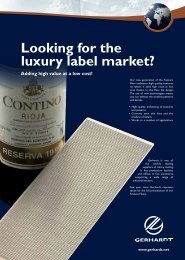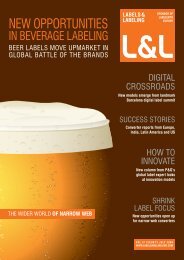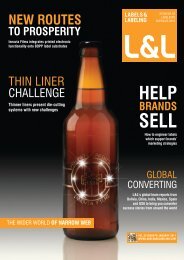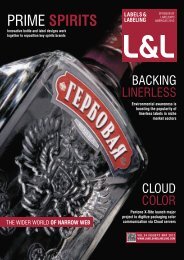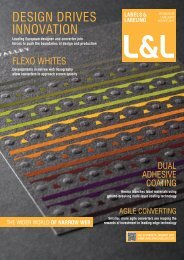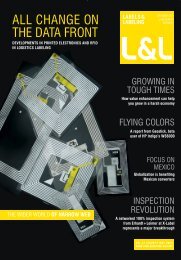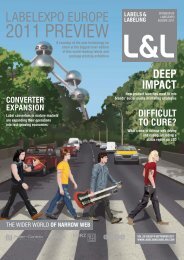You also want an ePaper? Increase the reach of your titles
YUMPU automatically turns print PDFs into web optimized ePapers that Google loves.
26 | L&L<br />
And this is at a time when<br />
governments, brand owners and retail<br />
groups are stepping up their demands<br />
and looking to move forward more<br />
rapidly with carbon reduction in the<br />
packaging and labeling supply chain.<br />
Certainly, the next few years will see an<br />
even bigger push on reducing carbon<br />
emissions – and the introduction of<br />
global ‘carbon credits.’ The label industry<br />
has yet to feel the full brunt of these new<br />
challenges.<br />
Yet, if the label industry is to convince<br />
brand owners, consumer groups and<br />
governments that labels are not a part<br />
of the problem – as it is often portrayed,<br />
and particularly for self-adhesive<br />
labels and release liner waste – then<br />
labels need to be promoted more as<br />
a means of carbon reduction. This is<br />
going to need a more collaborative<br />
relationship between industry suppliers,<br />
more positive marketing and PR, more<br />
good news stories, and definitive steps<br />
towards significantly lowering emissions.<br />
As Jussi Vanhanen, president of UPM<br />
Raflatac, stated at the recent L9 global<br />
industry forum in Tokyo, ‘It is more<br />
important than ever for the industry to<br />
focus its efforts on the efficient use of raw<br />
materials and resources. Doing nothing<br />
is not an option.’ His presentation was<br />
part of an L9 initiative aiming to stimulate<br />
global awareness and collaboration<br />
for recycling and sustainability in the<br />
self-adhesive labelstock industry. He also<br />
invited label printers and end-users to<br />
join labelstock suppliers in supporting<br />
the efficient use of raw materials and<br />
resources by promoting environmentally<br />
sound options.<br />
While the main labelstock suppliers are<br />
already starting to measure and reduce<br />
carbon emissions in their manufacturing<br />
and distribution chain, there are many<br />
other areas of label printing and<br />
converting where carbon emissions<br />
have an impact. How much do we really<br />
know about all of these? Inks and ink<br />
manufacture have a carbon footprint;<br />
label presses and the printing process<br />
have a carbon footprint; UV-curing<br />
has a carbon footprint; waste disposal<br />
and recycling has a carbon footprint;<br />
despatch of labels to the customer has a<br />
carbon footprint.<br />
From talking with many of the leading<br />
industry suppliers at the recent Finat<br />
Technical Seminar it seems that many<br />
of them are already starting to calculate<br />
the carbon footprint of their part of the<br />
label manufacturing supply chain. For<br />
example, Sun Chemical is working on<br />
this for some of its inks; Avery Dennison<br />
for substrates; GEW for UV ink drying;<br />
EskoArtwork for pre-press; Gallus<br />
for presses; Channelled Resources<br />
for recycling waste. Others are also<br />
embarking on measuring and recording<br />
CO2 emissions.<br />
However, what the industry really<br />
needs now is to achieve some joined-up<br />
thinking and improved supplier<br />
collaboration to fully understand where<br />
carbon emissions are created in the label<br />
industry supply chain, what elements of<br />
the label manufacturing process have the<br />
main impact, where reductions can and<br />
should be made, and then fully promote<br />
and market every major step forward in<br />
carbon reduction.<br />
Maybe label industry suppliers in the<br />
future will have a carbon footprint figure<br />
for their products on their own labels<br />
when despatched to the label converter.<br />
After all, if the major retail groups are<br />
putting a Carbon Footprint value on<br />
the product labels, why shouldn’t label<br />
industry suppliers be doing the same?<br />
It will probably also be necessary to<br />
work closely with label application and<br />
end-user companies. This way, the<br />
carbon footprint of the applied label<br />
might eventually be determined, and<br />
a true comparison against other forms<br />
of labeling obtained. Certainly, the<br />
applied label carbon footprint of shrink<br />
and stretch sleeve labels is already<br />
being promoted. How does the carbon<br />
footprint of self-adhesive and other forms<br />
of labeling compare with these, or with<br />
wrap-around film or in-mold labels?<br />
How can we effectively market and<br />
promote self-adhesive labels in an<br />
ever-more demanding carbon footprint<br />
reduction world if we don’t have<br />
all the answers? Let’s embrace the<br />
challenge and move forward to a more<br />
collaborative, joined-up, informed and<br />
positive future.




